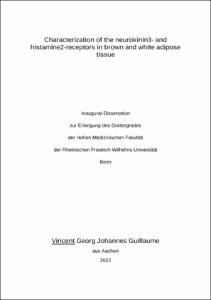Guillaume, Vincent Georg Johannes: Characterization of the neurokinin3- and histamine2-receptors in brown and white adipose tissue. - Bonn, 2022. - Dissertation, Rheinische Friedrich-Wilhelms-Universität Bonn.
Online-Ausgabe in bonndoc: https://nbn-resolving.org/urn:nbn:de:hbz:5-66353
Online-Ausgabe in bonndoc: https://nbn-resolving.org/urn:nbn:de:hbz:5-66353
@phdthesis{handle:20.500.11811/9750,
urn: https://nbn-resolving.org/urn:nbn:de:hbz:5-66353,
author = {{Vincent Georg Johannes Guillaume}},
title = {Characterization of the neurokinin3- and histamine2-receptors in brown and white adipose tissue},
school = {Rheinische Friedrich-Wilhelms-Universität Bonn},
year = 2022,
month = apr,
note = {Introduction: Obesity is a pandemic associated with severe health impairments. So far, the long-term success in treating obesity has been limited. Brown adipose tissue (BAT) is a promising therapeutical target as it features UCP-1, a unique protein which is able to uncouple the mitochondrial respiratory chain and thereby dissipate energy in form of heat. The pharmacological activation of BAT could therefore help tackling obesity. Here, we investigate the role of two G protein-coupled receptors - histamine2 receptor (Hrh2) and tachykinin3 (Tacr3) -receptor - in brown adipocytes (BA). These two receptors are described to be Gaq-coupled. Stimulation of Gaq signaling decreases the differentiation of BA. However, the receptors causing this negative regulation have not been identified, yet. Interestingly, the physiological roles of the Hrh2 and Tacr3-receptor have not been studied intensively. In this study, we investigated if pharmacological stimulation of Hrh2 or Tacr3 leads to alterations in differentiation and function of BA and white adipocytes (WA).
Methods: Murine brown and white pre-adipocytes were differentiated in vitro and treated with specific agonists and antagonists of Hrh2 or Tacr3 receptor. Differentiation was analyzed by measuring adipogenic (aP2, PPAR-γ) and thermogenic marker (UCP-1) genes on mRNA and protein level as well as by Oil-Red-O-Staining. We determined the effects of pharmacological modulation of Hrh2 and Tacr3 on lipolysis of mature BA. Moreover, cAMP- and DAG-ELISA were performed after Hrh2 and Tacr3 stimulation with specific agonists to elucidate g-protein coupling in BA. Histamine and tachykinin levels in the supernatant of BA upon stimulation with epinephrine were measured by ELISA. Finally, the influence of a normal vs. high-fat diet on the receptor expression ex vivo in various murine fat depots were scrutinized.
Results: Chronic treatment of both receptors did not alter differentiation of BA or WA comprehensively. However, low concentrations of the Tacr3 agonist senktide increased the expression of PPAR-γ, the master transcriptional regulator of adipogenesis. Furthermore, a specific antagonist of Tacr3 in co-stimulation with norepinephrine significantly modulated BA lipolysis. Receptor stimulation led to elevated DAG-levels which proposes a coupling of both receptors to the Gaq- signaling pathway. Tachykinin secretion of mature BA was significantly increased upon stimulation with epinephrine.
Conclusion: Overall, the presented results do not suggest a significant role of Hrh2 and Tacr3 on the differentiation and function of BA and WA.},
url = {https://hdl.handle.net/20.500.11811/9750}
}
urn: https://nbn-resolving.org/urn:nbn:de:hbz:5-66353,
author = {{Vincent Georg Johannes Guillaume}},
title = {Characterization of the neurokinin3- and histamine2-receptors in brown and white adipose tissue},
school = {Rheinische Friedrich-Wilhelms-Universität Bonn},
year = 2022,
month = apr,
note = {Introduction: Obesity is a pandemic associated with severe health impairments. So far, the long-term success in treating obesity has been limited. Brown adipose tissue (BAT) is a promising therapeutical target as it features UCP-1, a unique protein which is able to uncouple the mitochondrial respiratory chain and thereby dissipate energy in form of heat. The pharmacological activation of BAT could therefore help tackling obesity. Here, we investigate the role of two G protein-coupled receptors - histamine2 receptor (Hrh2) and tachykinin3 (Tacr3) -receptor - in brown adipocytes (BA). These two receptors are described to be Gaq-coupled. Stimulation of Gaq signaling decreases the differentiation of BA. However, the receptors causing this negative regulation have not been identified, yet. Interestingly, the physiological roles of the Hrh2 and Tacr3-receptor have not been studied intensively. In this study, we investigated if pharmacological stimulation of Hrh2 or Tacr3 leads to alterations in differentiation and function of BA and white adipocytes (WA).
Methods: Murine brown and white pre-adipocytes were differentiated in vitro and treated with specific agonists and antagonists of Hrh2 or Tacr3 receptor. Differentiation was analyzed by measuring adipogenic (aP2, PPAR-γ) and thermogenic marker (UCP-1) genes on mRNA and protein level as well as by Oil-Red-O-Staining. We determined the effects of pharmacological modulation of Hrh2 and Tacr3 on lipolysis of mature BA. Moreover, cAMP- and DAG-ELISA were performed after Hrh2 and Tacr3 stimulation with specific agonists to elucidate g-protein coupling in BA. Histamine and tachykinin levels in the supernatant of BA upon stimulation with epinephrine were measured by ELISA. Finally, the influence of a normal vs. high-fat diet on the receptor expression ex vivo in various murine fat depots were scrutinized.
Results: Chronic treatment of both receptors did not alter differentiation of BA or WA comprehensively. However, low concentrations of the Tacr3 agonist senktide increased the expression of PPAR-γ, the master transcriptional regulator of adipogenesis. Furthermore, a specific antagonist of Tacr3 in co-stimulation with norepinephrine significantly modulated BA lipolysis. Receptor stimulation led to elevated DAG-levels which proposes a coupling of both receptors to the Gaq- signaling pathway. Tachykinin secretion of mature BA was significantly increased upon stimulation with epinephrine.
Conclusion: Overall, the presented results do not suggest a significant role of Hrh2 and Tacr3 on the differentiation and function of BA and WA.},
url = {https://hdl.handle.net/20.500.11811/9750}
}






